CASE STUDY OF URINARY AND REPRODUCTIVE SYSTEM
VerifiedAdded on 2022/08/16
|7
|1749
|14
AI Summary
Contribute Materials
Your contribution can guide someone’s learning journey. Share your
documents today.
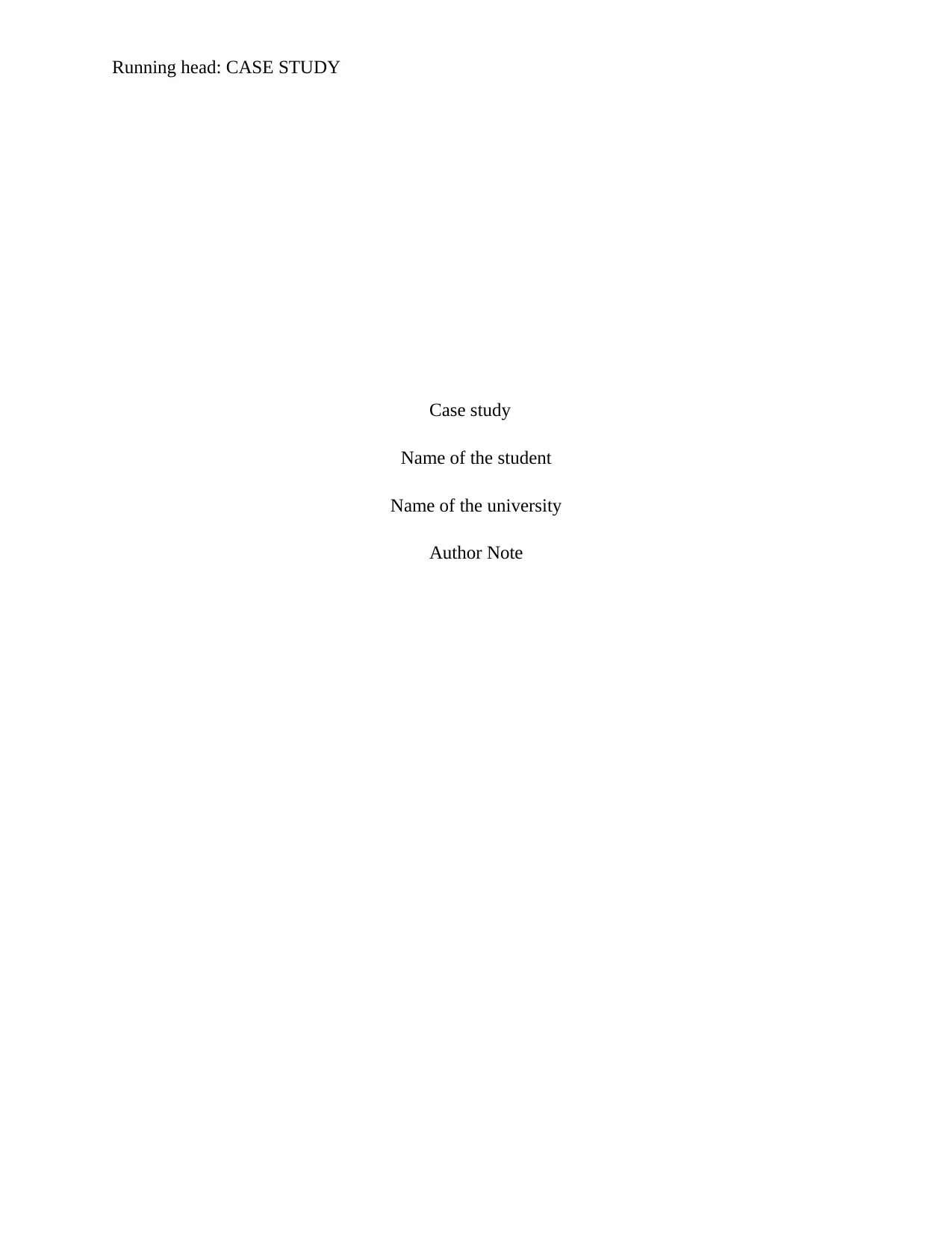
Running head: CASE STUDY
Case study
Name of the student
Name of the university
Author Note
Case study
Name of the student
Name of the university
Author Note
Secure Best Marks with AI Grader
Need help grading? Try our AI Grader for instant feedback on your assignments.
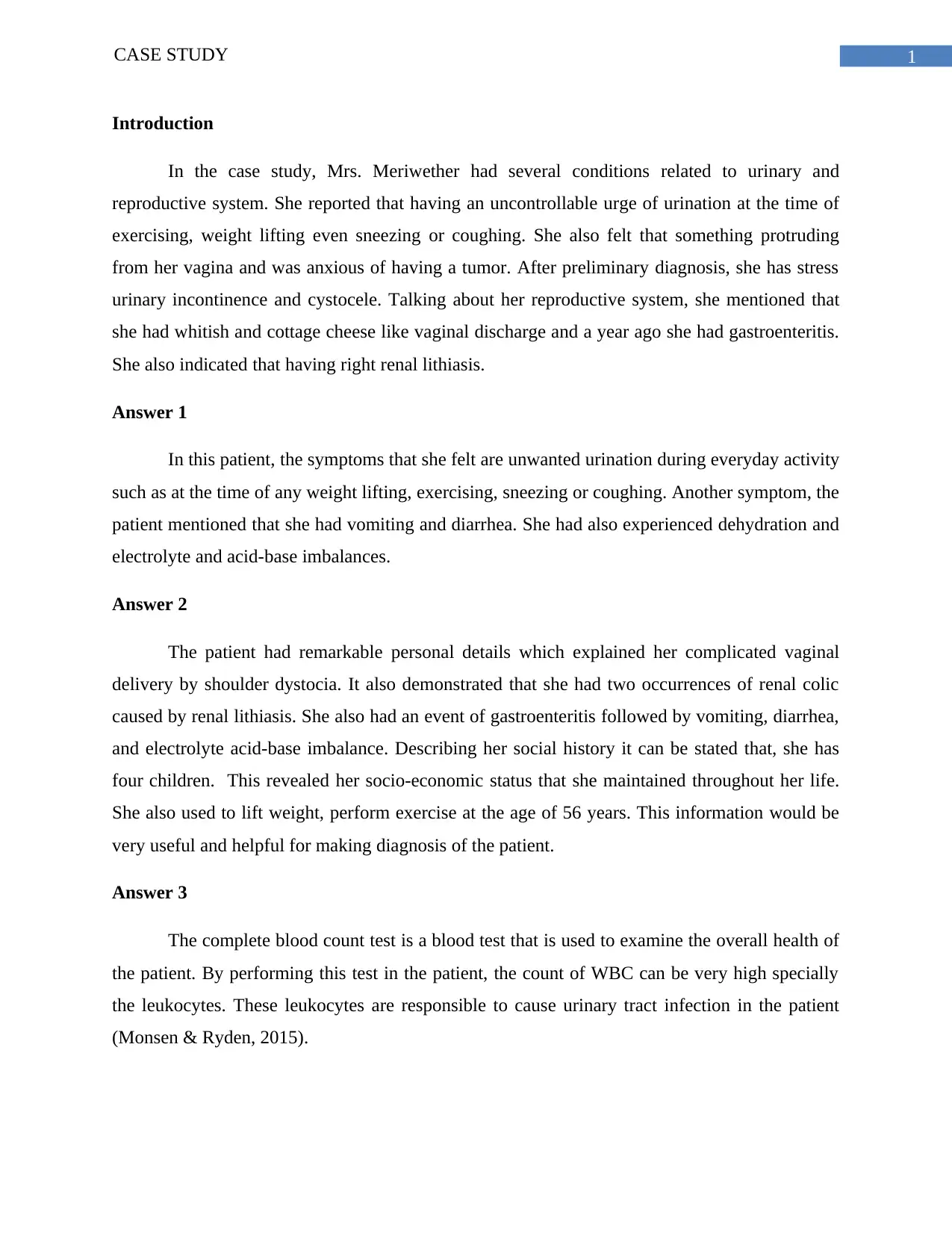
1CASE STUDY
Introduction
In the case study, Mrs. Meriwether had several conditions related to urinary and
reproductive system. She reported that having an uncontrollable urge of urination at the time of
exercising, weight lifting even sneezing or coughing. She also felt that something protruding
from her vagina and was anxious of having a tumor. After preliminary diagnosis, she has stress
urinary incontinence and cystocele. Talking about her reproductive system, she mentioned that
she had whitish and cottage cheese like vaginal discharge and a year ago she had gastroenteritis.
She also indicated that having right renal lithiasis.
Answer 1
In this patient, the symptoms that she felt are unwanted urination during everyday activity
such as at the time of any weight lifting, exercising, sneezing or coughing. Another symptom, the
patient mentioned that she had vomiting and diarrhea. She had also experienced dehydration and
electrolyte and acid-base imbalances.
Answer 2
The patient had remarkable personal details which explained her complicated vaginal
delivery by shoulder dystocia. It also demonstrated that she had two occurrences of renal colic
caused by renal lithiasis. She also had an event of gastroenteritis followed by vomiting, diarrhea,
and electrolyte acid-base imbalance. Describing her social history it can be stated that, she has
four children. This revealed her socio-economic status that she maintained throughout her life.
She also used to lift weight, perform exercise at the age of 56 years. This information would be
very useful and helpful for making diagnosis of the patient.
Answer 3
The complete blood count test is a blood test that is used to examine the overall health of
the patient. By performing this test in the patient, the count of WBC can be very high specially
the leukocytes. These leukocytes are responsible to cause urinary tract infection in the patient
(Monsen & Ryden, 2015).
Introduction
In the case study, Mrs. Meriwether had several conditions related to urinary and
reproductive system. She reported that having an uncontrollable urge of urination at the time of
exercising, weight lifting even sneezing or coughing. She also felt that something protruding
from her vagina and was anxious of having a tumor. After preliminary diagnosis, she has stress
urinary incontinence and cystocele. Talking about her reproductive system, she mentioned that
she had whitish and cottage cheese like vaginal discharge and a year ago she had gastroenteritis.
She also indicated that having right renal lithiasis.
Answer 1
In this patient, the symptoms that she felt are unwanted urination during everyday activity
such as at the time of any weight lifting, exercising, sneezing or coughing. Another symptom, the
patient mentioned that she had vomiting and diarrhea. She had also experienced dehydration and
electrolyte and acid-base imbalances.
Answer 2
The patient had remarkable personal details which explained her complicated vaginal
delivery by shoulder dystocia. It also demonstrated that she had two occurrences of renal colic
caused by renal lithiasis. She also had an event of gastroenteritis followed by vomiting, diarrhea,
and electrolyte acid-base imbalance. Describing her social history it can be stated that, she has
four children. This revealed her socio-economic status that she maintained throughout her life.
She also used to lift weight, perform exercise at the age of 56 years. This information would be
very useful and helpful for making diagnosis of the patient.
Answer 3
The complete blood count test is a blood test that is used to examine the overall health of
the patient. By performing this test in the patient, the count of WBC can be very high specially
the leukocytes. These leukocytes are responsible to cause urinary tract infection in the patient
(Monsen & Ryden, 2015).
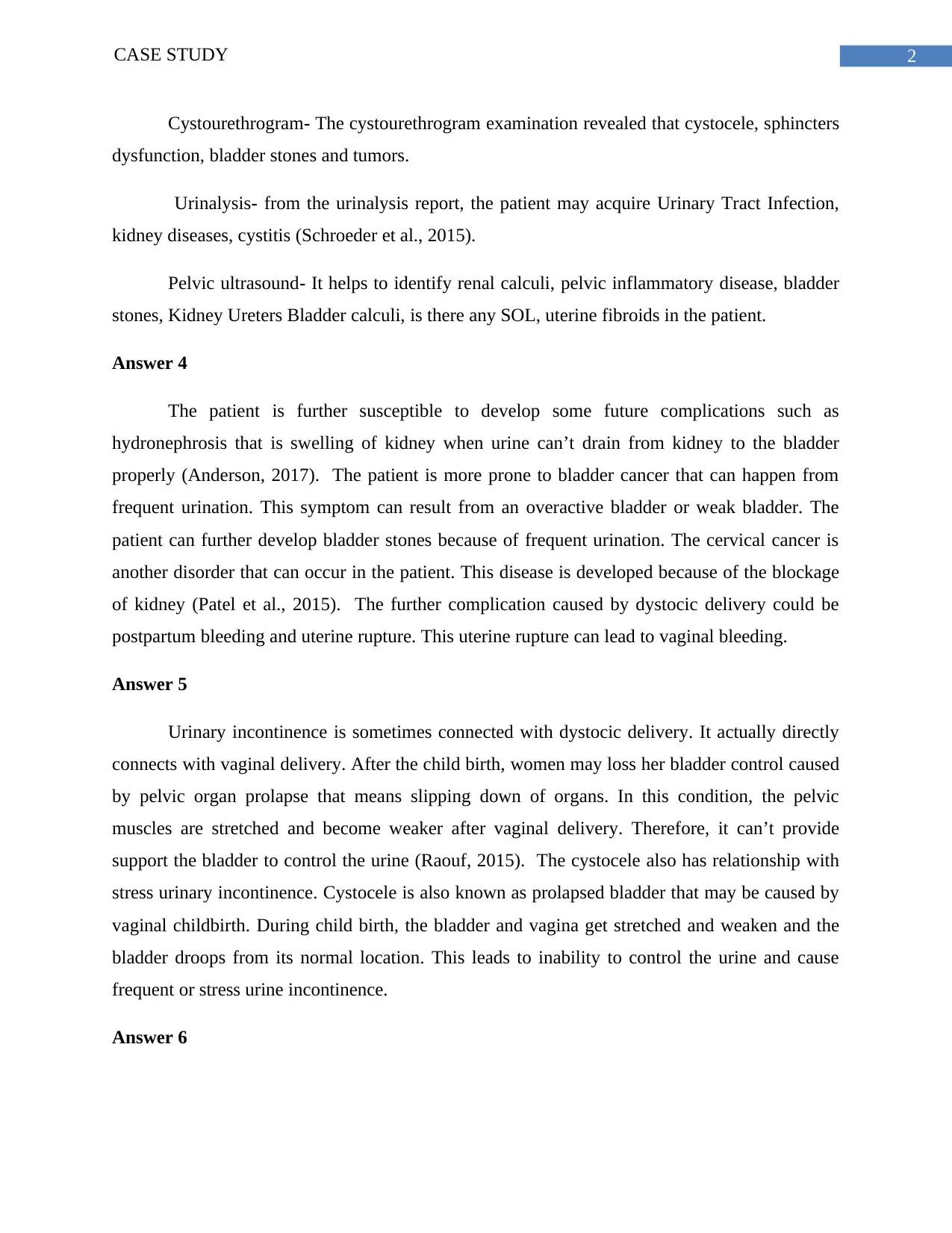
2CASE STUDY
Cystourethrogram- The cystourethrogram examination revealed that cystocele, sphincters
dysfunction, bladder stones and tumors.
Urinalysis- from the urinalysis report, the patient may acquire Urinary Tract Infection,
kidney diseases, cystitis (Schroeder et al., 2015).
Pelvic ultrasound- It helps to identify renal calculi, pelvic inflammatory disease, bladder
stones, Kidney Ureters Bladder calculi, is there any SOL, uterine fibroids in the patient.
Answer 4
The patient is further susceptible to develop some future complications such as
hydronephrosis that is swelling of kidney when urine can’t drain from kidney to the bladder
properly (Anderson, 2017). The patient is more prone to bladder cancer that can happen from
frequent urination. This symptom can result from an overactive bladder or weak bladder. The
patient can further develop bladder stones because of frequent urination. The cervical cancer is
another disorder that can occur in the patient. This disease is developed because of the blockage
of kidney (Patel et al., 2015). The further complication caused by dystocic delivery could be
postpartum bleeding and uterine rupture. This uterine rupture can lead to vaginal bleeding.
Answer 5
Urinary incontinence is sometimes connected with dystocic delivery. It actually directly
connects with vaginal delivery. After the child birth, women may loss her bladder control caused
by pelvic organ prolapse that means slipping down of organs. In this condition, the pelvic
muscles are stretched and become weaker after vaginal delivery. Therefore, it can’t provide
support the bladder to control the urine (Raouf, 2015). The cystocele also has relationship with
stress urinary incontinence. Cystocele is also known as prolapsed bladder that may be caused by
vaginal childbirth. During child birth, the bladder and vagina get stretched and weaken and the
bladder droops from its normal location. This leads to inability to control the urine and cause
frequent or stress urine incontinence.
Answer 6
Cystourethrogram- The cystourethrogram examination revealed that cystocele, sphincters
dysfunction, bladder stones and tumors.
Urinalysis- from the urinalysis report, the patient may acquire Urinary Tract Infection,
kidney diseases, cystitis (Schroeder et al., 2015).
Pelvic ultrasound- It helps to identify renal calculi, pelvic inflammatory disease, bladder
stones, Kidney Ureters Bladder calculi, is there any SOL, uterine fibroids in the patient.
Answer 4
The patient is further susceptible to develop some future complications such as
hydronephrosis that is swelling of kidney when urine can’t drain from kidney to the bladder
properly (Anderson, 2017). The patient is more prone to bladder cancer that can happen from
frequent urination. This symptom can result from an overactive bladder or weak bladder. The
patient can further develop bladder stones because of frequent urination. The cervical cancer is
another disorder that can occur in the patient. This disease is developed because of the blockage
of kidney (Patel et al., 2015). The further complication caused by dystocic delivery could be
postpartum bleeding and uterine rupture. This uterine rupture can lead to vaginal bleeding.
Answer 5
Urinary incontinence is sometimes connected with dystocic delivery. It actually directly
connects with vaginal delivery. After the child birth, women may loss her bladder control caused
by pelvic organ prolapse that means slipping down of organs. In this condition, the pelvic
muscles are stretched and become weaker after vaginal delivery. Therefore, it can’t provide
support the bladder to control the urine (Raouf, 2015). The cystocele also has relationship with
stress urinary incontinence. Cystocele is also known as prolapsed bladder that may be caused by
vaginal childbirth. During child birth, the bladder and vagina get stretched and weaken and the
bladder droops from its normal location. This leads to inability to control the urine and cause
frequent or stress urine incontinence.
Answer 6
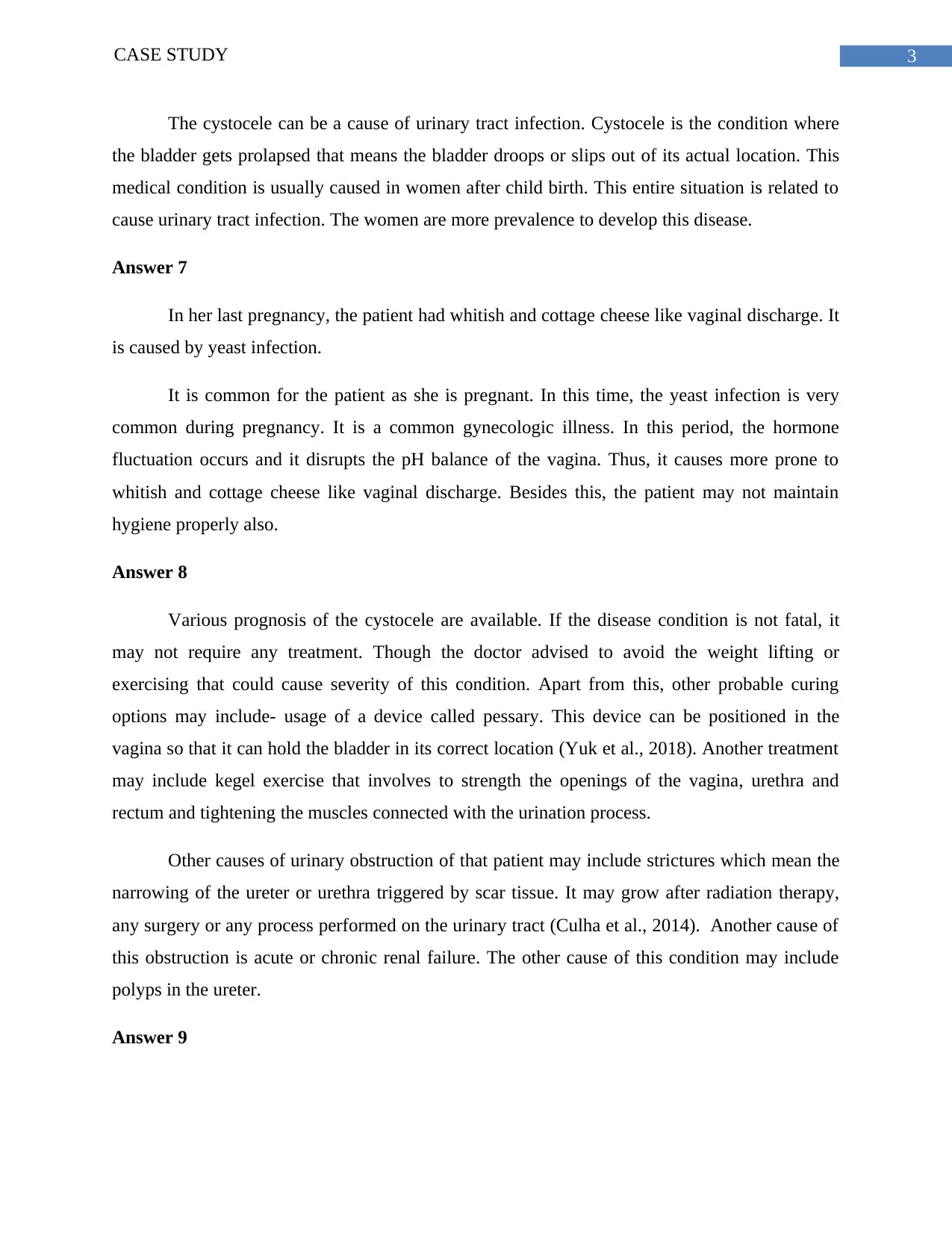
3CASE STUDY
The cystocele can be a cause of urinary tract infection. Cystocele is the condition where
the bladder gets prolapsed that means the bladder droops or slips out of its actual location. This
medical condition is usually caused in women after child birth. This entire situation is related to
cause urinary tract infection. The women are more prevalence to develop this disease.
Answer 7
In her last pregnancy, the patient had whitish and cottage cheese like vaginal discharge. It
is caused by yeast infection.
It is common for the patient as she is pregnant. In this time, the yeast infection is very
common during pregnancy. It is a common gynecologic illness. In this period, the hormone
fluctuation occurs and it disrupts the pH balance of the vagina. Thus, it causes more prone to
whitish and cottage cheese like vaginal discharge. Besides this, the patient may not maintain
hygiene properly also.
Answer 8
Various prognosis of the cystocele are available. If the disease condition is not fatal, it
may not require any treatment. Though the doctor advised to avoid the weight lifting or
exercising that could cause severity of this condition. Apart from this, other probable curing
options may include- usage of a device called pessary. This device can be positioned in the
vagina so that it can hold the bladder in its correct location (Yuk et al., 2018). Another treatment
may include kegel exercise that involves to strength the openings of the vagina, urethra and
rectum and tightening the muscles connected with the urination process.
Other causes of urinary obstruction of that patient may include strictures which mean the
narrowing of the ureter or urethra triggered by scar tissue. It may grow after radiation therapy,
any surgery or any process performed on the urinary tract (Culha et al., 2014). Another cause of
this obstruction is acute or chronic renal failure. The other cause of this condition may include
polyps in the ureter.
Answer 9
The cystocele can be a cause of urinary tract infection. Cystocele is the condition where
the bladder gets prolapsed that means the bladder droops or slips out of its actual location. This
medical condition is usually caused in women after child birth. This entire situation is related to
cause urinary tract infection. The women are more prevalence to develop this disease.
Answer 7
In her last pregnancy, the patient had whitish and cottage cheese like vaginal discharge. It
is caused by yeast infection.
It is common for the patient as she is pregnant. In this time, the yeast infection is very
common during pregnancy. It is a common gynecologic illness. In this period, the hormone
fluctuation occurs and it disrupts the pH balance of the vagina. Thus, it causes more prone to
whitish and cottage cheese like vaginal discharge. Besides this, the patient may not maintain
hygiene properly also.
Answer 8
Various prognosis of the cystocele are available. If the disease condition is not fatal, it
may not require any treatment. Though the doctor advised to avoid the weight lifting or
exercising that could cause severity of this condition. Apart from this, other probable curing
options may include- usage of a device called pessary. This device can be positioned in the
vagina so that it can hold the bladder in its correct location (Yuk et al., 2018). Another treatment
may include kegel exercise that involves to strength the openings of the vagina, urethra and
rectum and tightening the muscles connected with the urination process.
Other causes of urinary obstruction of that patient may include strictures which mean the
narrowing of the ureter or urethra triggered by scar tissue. It may grow after radiation therapy,
any surgery or any process performed on the urinary tract (Culha et al., 2014). Another cause of
this obstruction is acute or chronic renal failure. The other cause of this condition may include
polyps in the ureter.
Answer 9
Secure Best Marks with AI Grader
Need help grading? Try our AI Grader for instant feedback on your assignments.
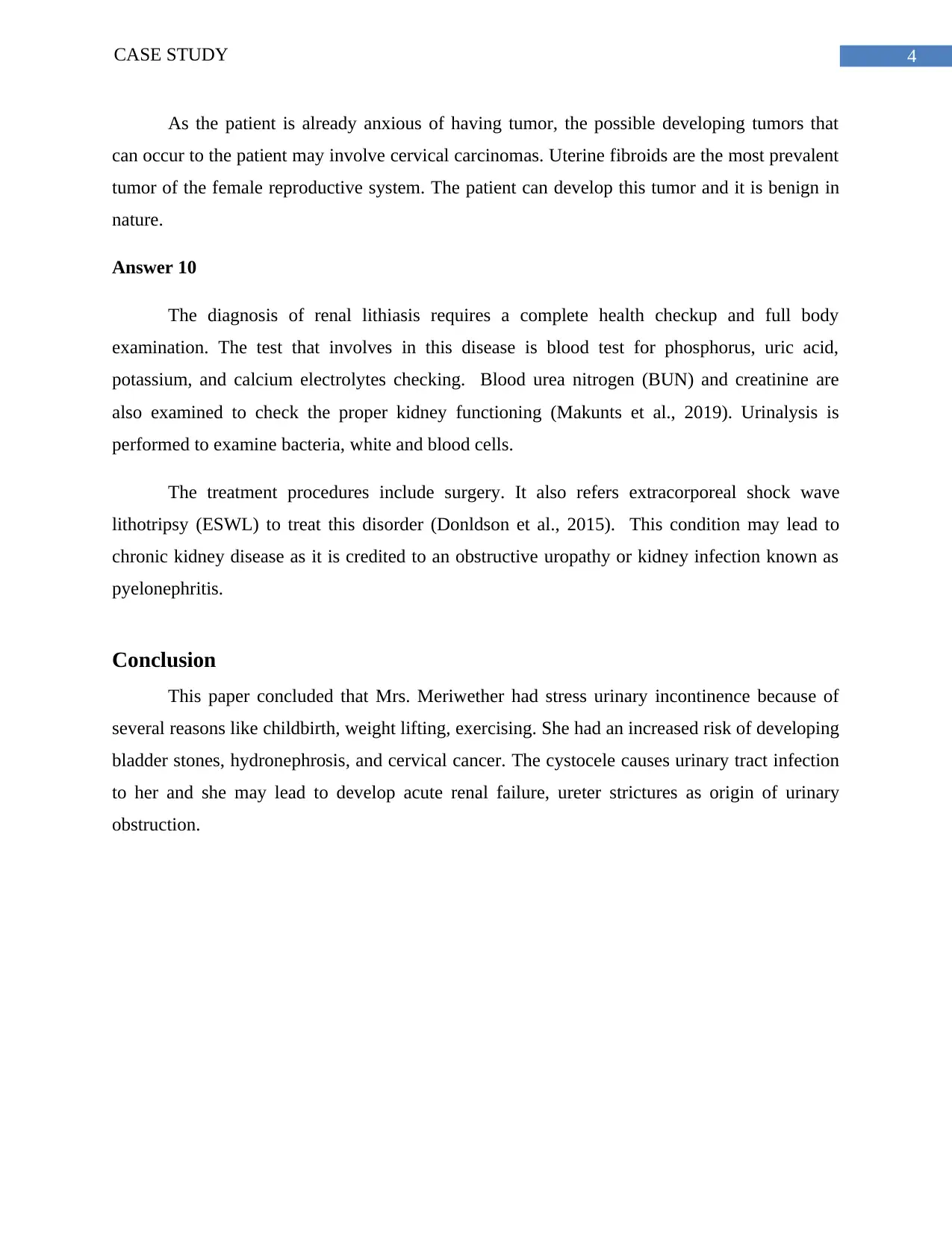
4CASE STUDY
As the patient is already anxious of having tumor, the possible developing tumors that
can occur to the patient may involve cervical carcinomas. Uterine fibroids are the most prevalent
tumor of the female reproductive system. The patient can develop this tumor and it is benign in
nature.
Answer 10
The diagnosis of renal lithiasis requires a complete health checkup and full body
examination. The test that involves in this disease is blood test for phosphorus, uric acid,
potassium, and calcium electrolytes checking. Blood urea nitrogen (BUN) and creatinine are
also examined to check the proper kidney functioning (Makunts et al., 2019). Urinalysis is
performed to examine bacteria, white and blood cells.
The treatment procedures include surgery. It also refers extracorporeal shock wave
lithotripsy (ESWL) to treat this disorder (Donldson et al., 2015). This condition may lead to
chronic kidney disease as it is credited to an obstructive uropathy or kidney infection known as
pyelonephritis.
Conclusion
This paper concluded that Mrs. Meriwether had stress urinary incontinence because of
several reasons like childbirth, weight lifting, exercising. She had an increased risk of developing
bladder stones, hydronephrosis, and cervical cancer. The cystocele causes urinary tract infection
to her and she may lead to develop acute renal failure, ureter strictures as origin of urinary
obstruction.
As the patient is already anxious of having tumor, the possible developing tumors that
can occur to the patient may involve cervical carcinomas. Uterine fibroids are the most prevalent
tumor of the female reproductive system. The patient can develop this tumor and it is benign in
nature.
Answer 10
The diagnosis of renal lithiasis requires a complete health checkup and full body
examination. The test that involves in this disease is blood test for phosphorus, uric acid,
potassium, and calcium electrolytes checking. Blood urea nitrogen (BUN) and creatinine are
also examined to check the proper kidney functioning (Makunts et al., 2019). Urinalysis is
performed to examine bacteria, white and blood cells.
The treatment procedures include surgery. It also refers extracorporeal shock wave
lithotripsy (ESWL) to treat this disorder (Donldson et al., 2015). This condition may lead to
chronic kidney disease as it is credited to an obstructive uropathy or kidney infection known as
pyelonephritis.
Conclusion
This paper concluded that Mrs. Meriwether had stress urinary incontinence because of
several reasons like childbirth, weight lifting, exercising. She had an increased risk of developing
bladder stones, hydronephrosis, and cervical cancer. The cystocele causes urinary tract infection
to her and she may lead to develop acute renal failure, ureter strictures as origin of urinary
obstruction.
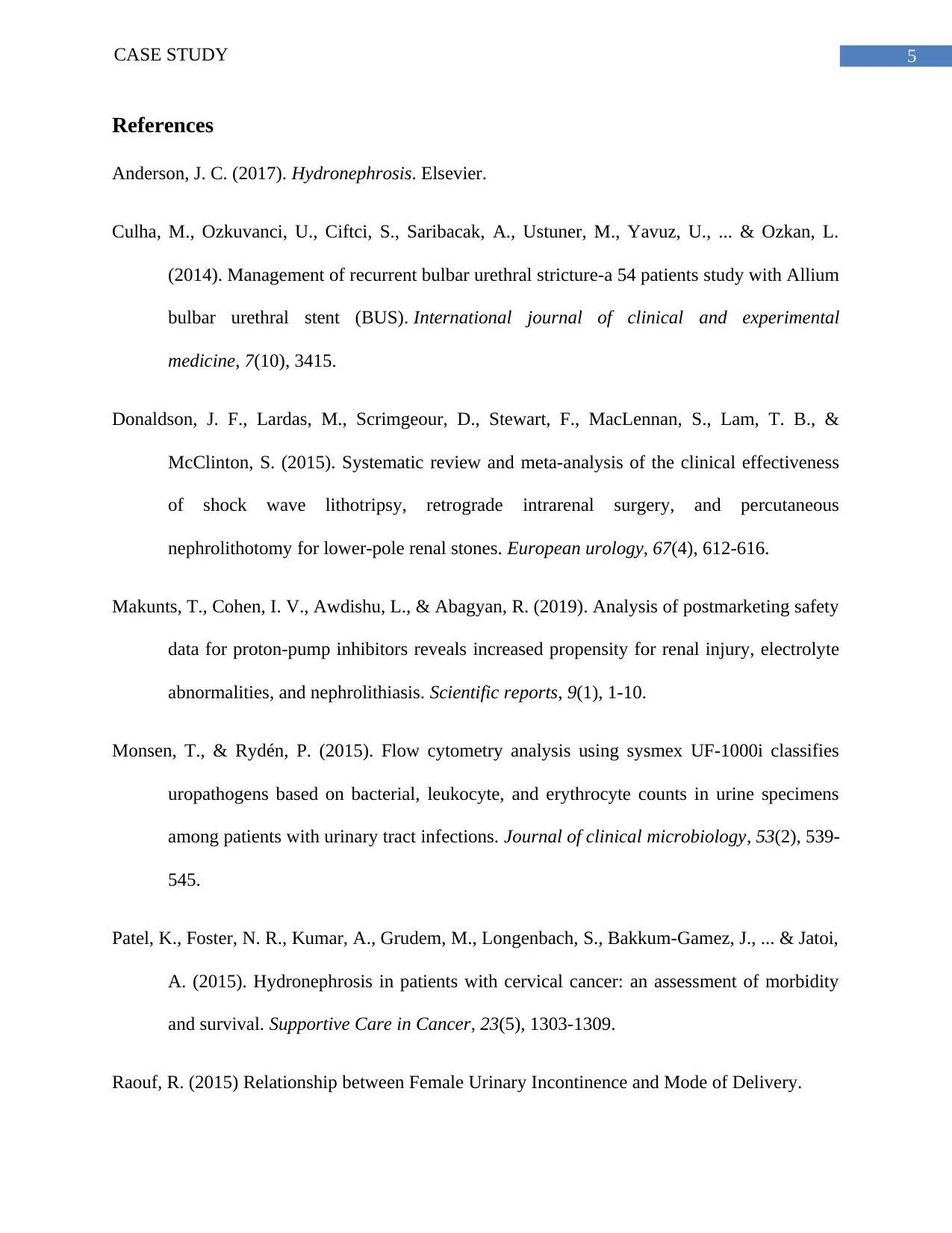
5CASE STUDY
References
Anderson, J. C. (2017). Hydronephrosis. Elsevier.
Culha, M., Ozkuvanci, U., Ciftci, S., Saribacak, A., Ustuner, M., Yavuz, U., ... & Ozkan, L.
(2014). Management of recurrent bulbar urethral stricture-a 54 patients study with Allium
bulbar urethral stent (BUS). International journal of clinical and experimental
medicine, 7(10), 3415.
Donaldson, J. F., Lardas, M., Scrimgeour, D., Stewart, F., MacLennan, S., Lam, T. B., &
McClinton, S. (2015). Systematic review and meta-analysis of the clinical effectiveness
of shock wave lithotripsy, retrograde intrarenal surgery, and percutaneous
nephrolithotomy for lower-pole renal stones. European urology, 67(4), 612-616.
Makunts, T., Cohen, I. V., Awdishu, L., & Abagyan, R. (2019). Analysis of postmarketing safety
data for proton-pump inhibitors reveals increased propensity for renal injury, electrolyte
abnormalities, and nephrolithiasis. Scientific reports, 9(1), 1-10.
Monsen, T., & Rydén, P. (2015). Flow cytometry analysis using sysmex UF-1000i classifies
uropathogens based on bacterial, leukocyte, and erythrocyte counts in urine specimens
among patients with urinary tract infections. Journal of clinical microbiology, 53(2), 539-
545.
Patel, K., Foster, N. R., Kumar, A., Grudem, M., Longenbach, S., Bakkum-Gamez, J., ... & Jatoi,
A. (2015). Hydronephrosis in patients with cervical cancer: an assessment of morbidity
and survival. Supportive Care in Cancer, 23(5), 1303-1309.
Raouf, R. (2015) Relationship between Female Urinary Incontinence and Mode of Delivery.
References
Anderson, J. C. (2017). Hydronephrosis. Elsevier.
Culha, M., Ozkuvanci, U., Ciftci, S., Saribacak, A., Ustuner, M., Yavuz, U., ... & Ozkan, L.
(2014). Management of recurrent bulbar urethral stricture-a 54 patients study with Allium
bulbar urethral stent (BUS). International journal of clinical and experimental
medicine, 7(10), 3415.
Donaldson, J. F., Lardas, M., Scrimgeour, D., Stewart, F., MacLennan, S., Lam, T. B., &
McClinton, S. (2015). Systematic review and meta-analysis of the clinical effectiveness
of shock wave lithotripsy, retrograde intrarenal surgery, and percutaneous
nephrolithotomy for lower-pole renal stones. European urology, 67(4), 612-616.
Makunts, T., Cohen, I. V., Awdishu, L., & Abagyan, R. (2019). Analysis of postmarketing safety
data for proton-pump inhibitors reveals increased propensity for renal injury, electrolyte
abnormalities, and nephrolithiasis. Scientific reports, 9(1), 1-10.
Monsen, T., & Rydén, P. (2015). Flow cytometry analysis using sysmex UF-1000i classifies
uropathogens based on bacterial, leukocyte, and erythrocyte counts in urine specimens
among patients with urinary tract infections. Journal of clinical microbiology, 53(2), 539-
545.
Patel, K., Foster, N. R., Kumar, A., Grudem, M., Longenbach, S., Bakkum-Gamez, J., ... & Jatoi,
A. (2015). Hydronephrosis in patients with cervical cancer: an assessment of morbidity
and survival. Supportive Care in Cancer, 23(5), 1303-1309.
Raouf, R. (2015) Relationship between Female Urinary Incontinence and Mode of Delivery.
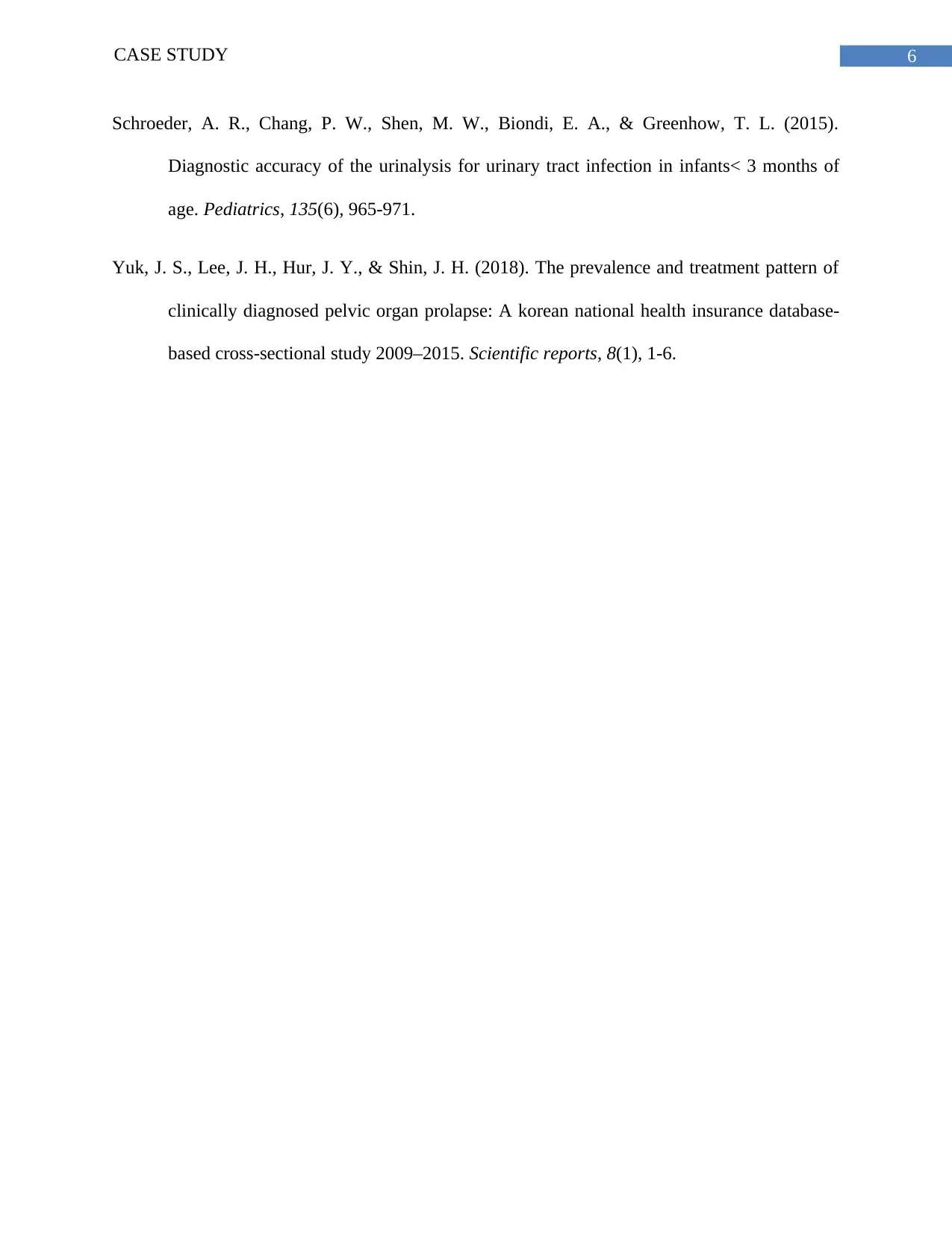
6CASE STUDY
Schroeder, A. R., Chang, P. W., Shen, M. W., Biondi, E. A., & Greenhow, T. L. (2015).
Diagnostic accuracy of the urinalysis for urinary tract infection in infants< 3 months of
age. Pediatrics, 135(6), 965-971.
Yuk, J. S., Lee, J. H., Hur, J. Y., & Shin, J. H. (2018). The prevalence and treatment pattern of
clinically diagnosed pelvic organ prolapse: A korean national health insurance database-
based cross-sectional study 2009–2015. Scientific reports, 8(1), 1-6.
Schroeder, A. R., Chang, P. W., Shen, M. W., Biondi, E. A., & Greenhow, T. L. (2015).
Diagnostic accuracy of the urinalysis for urinary tract infection in infants< 3 months of
age. Pediatrics, 135(6), 965-971.
Yuk, J. S., Lee, J. H., Hur, J. Y., & Shin, J. H. (2018). The prevalence and treatment pattern of
clinically diagnosed pelvic organ prolapse: A korean national health insurance database-
based cross-sectional study 2009–2015. Scientific reports, 8(1), 1-6.
1 out of 7
Related Documents
Your All-in-One AI-Powered Toolkit for Academic Success.
+13062052269
info@desklib.com
Available 24*7 on WhatsApp / Email
![[object Object]](/_next/static/media/star-bottom.7253800d.svg)
Unlock your academic potential
© 2024 | Zucol Services PVT LTD | All rights reserved.
